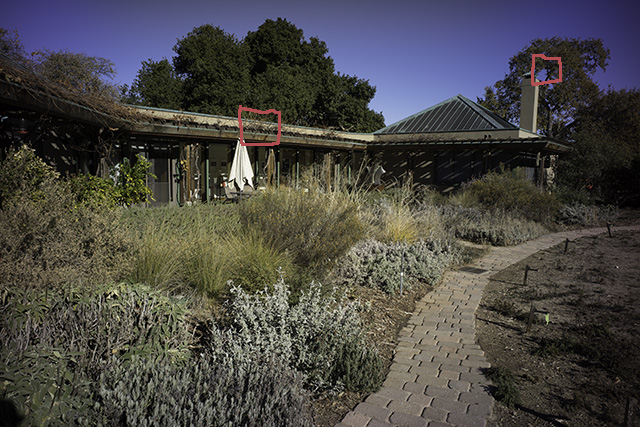I few posts ago, the results for the Leica 24mm f/3.8 Elmar were degraded because the Novaflex adapter I was using was a little too thin, so that when I focused the lens on infinity with the scale engraved on the lens, I was actually focusing beyond infinity. Beyond infinity, let that roll around in your head for a few minutes. Doesn’t make sense, does it? But, viewed another way, it does.
Enough philosophy. I redid the 24mm Elmar tests, this time in a manner calculated to stay on the right side of infinity. I set up on the usual subject:
I opened the aperture all the way, and used the magnified focus feature on the grape branches in the left red square, using a loupe on the LCD display. By the way, being able to angle the LCD display is a really nice feature for this kind of precise work. In a camera with a non-articulated LDC screen, you have the choice of setting the tripod high enough so that you can focus comfortable, but you can’t see what f-stop you’ve picked, or setting it a little lower, so you can see the top of the lens, but it hurts your back to bend over to look at the LCD screen.
I set the ISO to 100, and made a series with apertures of f/4, f/5.6, f/8, f/11, and f/16. Then I scooted the focus rectangle over to the tree at the upper right, opened the lens up all the way, and focused on it. Then I made another series at the same apertures. Finally, I made a series at all those apertures, focusing on the tree at the shooting aperture before each exposure.
I ended up with fifteen images, and in each image I was interested in two areas. Rather than bore you by posting all thirty images, I’ll give you my opinions, and post links to two Photoshop images, each one of which contains 15 layers, one for each image.
- Not surprisingly, the Sony a7R and the 24mm Elmar play better together when the lens is accurately focused using the LCD screen.
- There are differences between the focus settings for the vines and the trees, but they’re small.
- There are differences in the focus settings for the trees at different f-stops, but they’re small, too. With the finder mode set to Setting Effect Off, things get too dark to focus accurately at f/16, and f/11 is a little tricky.
- f/5.6 is the best aperture for the Elmar at the more central location, with f/8 not far behind.
- When focused on the vines, the trees are best at f/11. f/8 is close. f/5.6 and f/16 exhibit similar sharpness, and f/4 is worse.
- When focused wide open on the trees, f/8 and f/11 give the best results. If I were forced to choose, I’d pick f/11, but you wouldn’t see the difference in a print. f/5.6 and f/16 exhibit similar sharpness, and f/4 is worse.
- Focusing stopped down on the trees yields similar results to focusing wide open.
Here’s an image that was made by focusing wide open on the tree and exposing at f/11:
Here’s a link to Photoshop file of the vines.
Here’s a link to Photoshop file of the trees.
Next up is the Zeiss 21mm f/2.8 ZF.2.


Leave a Reply